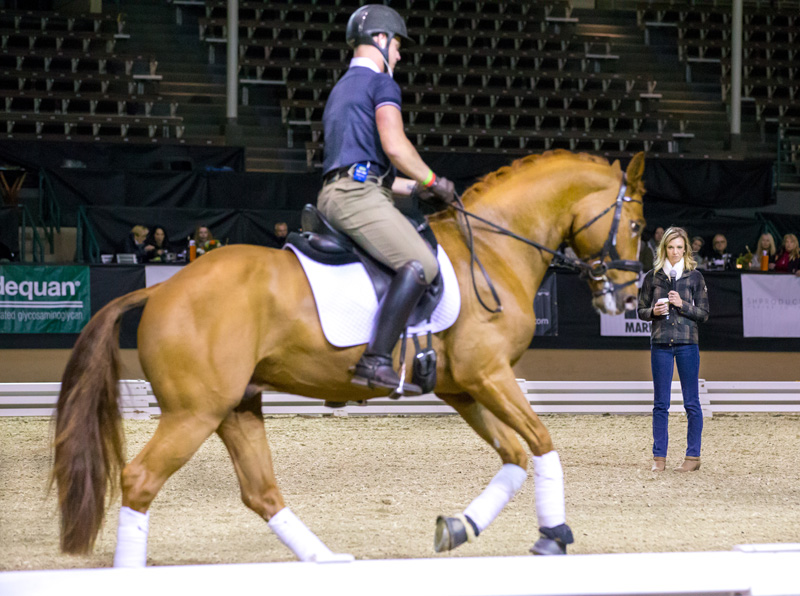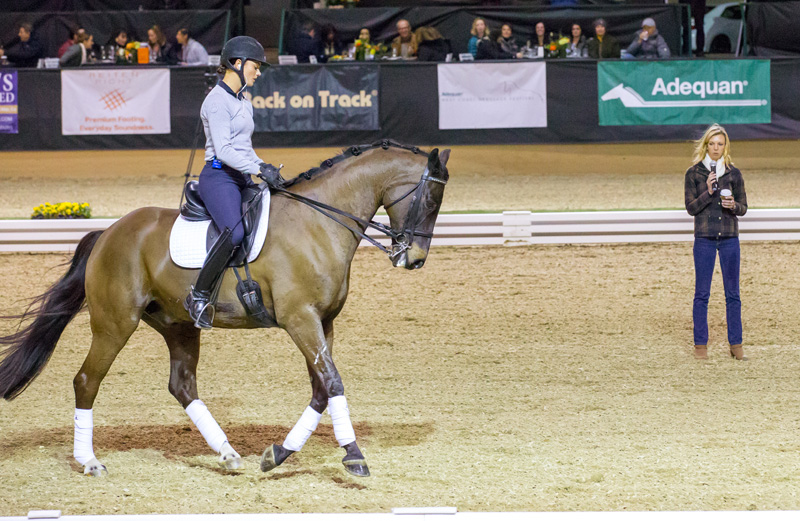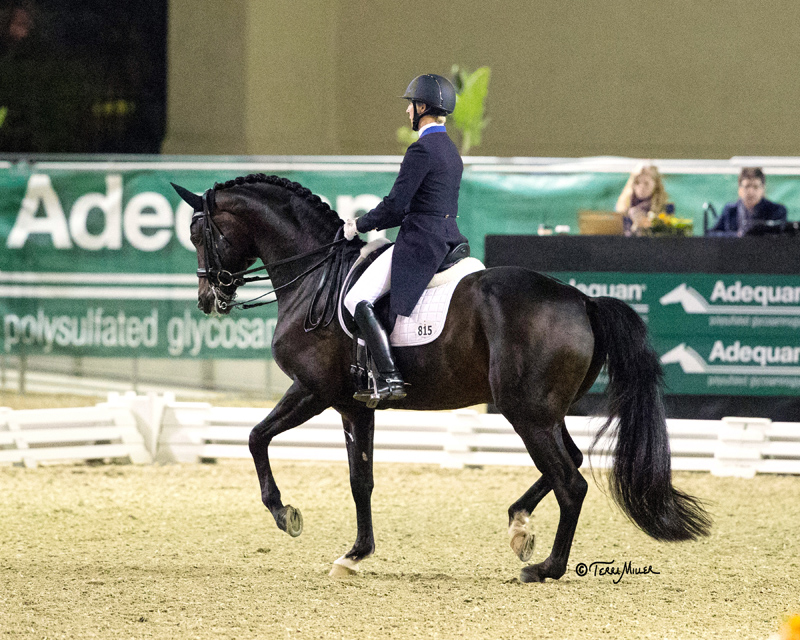Del Mar, Calif.—Jan. 20
Fresh off winning the William C. Steinkraus Trophy for her accomplishments in 2017, Laura Graves, the top-ranked U.S. dressage rider, conducted a masterclass at the Adequan West Coast Dressage Festival in Del Mar, California.
She finds her greatest satisfaction from bringing horses along from the beginning, and she proved to be a thoughtful and focused clinician, working with three horse-and-rider combinations over the course of an hour. The clinic was live-streamed on Facebook and had more than 16,000 views.
Watch it here (the masterclass starts at minute 5 and lasts an hour, followed by the Grand Prix freestyle competition):
Embrace The Mistakes
Andrew Rommens of Solana Beach, California, was up first, riding Scott Hayes’ 6-year-old Sun King DSF (Sir Gregory—Weliebre, Weltmeyer). The Oldenburg gelding is still green at second level, and he struggled with his composure in the Del Mar arena’s charged setting, but Graves urged Rommens to use the experience, even if mistakes come with the territory.
As he warmed up at trot, Rommens played with rhythm and tempo, which drew praise from Graves, who suggested that the pair also test the boundaries of their comfort zone. “If you stay where it’s safe, you’re never going to be able to push the envelope. Especially with the younger horses, they don’t learn if they don’t make mistakes,” she said.
At trot, she had the pair make circles of varying sizes, working on transitions between the gaits. Keeping a reactive horse moving forward may seem like the best choice, but Graves noted that slowing the horse’s tempo—even if it temporarily makes the issue worse—is more effective in the long run.
“Stay close to the place where you’re going to make the progress,” Graves said. “Stay close to the place that’s a problem. If you don’t get close enough to it, we’re never going to improve it.”
If a horse becomes spooky along the rail, using turns and circles or doing leg yields on a circle helps the rider control positioning without pulling on the reins.
For Graves, submission through suppleness is critical. “That means the horse accepts both the leg and the rein aids with suppleness through his entire topline rather than increasing tension in the muscles when I touch with my leg or my hand,” she said. Particularly in a show or clinic environment, the rider must always feel that the horse is listening.
“Even if the horse is spooky or looky or a little resistant, you have to be able to create something, even if it’s not what’s natural in this moment,” Graves said. “You’ve got to find a way to put the leg on.”
ADVERTISEMENT
In canter, Rommens again played on adjusting the tempo. When Romans encountered resistance, Graves had him circle and position the horse to control the outside shoulder. “Just because he’s feeling frisky or nervous, he doesn’t get to regulate anything,” she said.

Andrew Rommens worked on the canter rhythm with Sun King DSF as Laura Graves instructed. Photo by Terri Miller
When Rommens struggled to bring the horse back to trot in the tempo he wanted, Graves had him post the canter and ride the horse forward into trot, then continue to transition from canter to trot and back again. “He’s learning all these different kinds of canters,” she said. “If we stay close to the canter that’s a problem, that’s where we need to do the work.” If the rider has to kick the horse forward into canter or allows him to make a bad transition to trot or walk, the horse doesn’t learn.
To increase suppleness and encourage the horse to use both sides of his body, the pair then worked in counter-canter before riding the trot transition. Riders must pay attention to how the horse is responding, Graves emphasized. If the horse comes back too much or drops the contact, wait to make the transition. “Don’t be committed to something if it’s not going to happen for a 10,” she said.
Sensitive or temperamental horses benefit from a rider who pays close attention to things that may not seem like a big deal, Graves said. “If you think walk, and he goes to drop out from under you, your job is to listen. It’s going to be what makes him rideable or not when he gets older.” If a rider hasn’t spent the time perfecting movements like canter-trot and trot-walk transitions, the one-tempis and piaffe will be impossible to control. Having a horse that understands and responds to the rider’s aids is the goal.
Better To Be Good Than Lucky
Christine Unruh of San Diego, California, followed, riding Janet Harris’ fourth level gelding Charming Rav (Charming—Sun Day), a 14-year-old Westphalian. As the pair cantered down the long side, Graves asked Unruh to show a little haunches-in and shoulder-in to assess the horse’s suppleness on both leads, and then ride a half pass into counter-canter before making the flying change.
If the horse becomes reactive to the rider’s leg, taking the leg off rewards the horse’s behavior, Graves explained.
As the pair worked on tempi changes, Graves urged Unruh to maintain the same canter tempo, making sure the horse didn’t run or get too deep. If the horse drops the contact, Graves recommended that Unruh re-establish self-carriage in a balanced canter before resuming the exercise. “Riding a change for a 6 is not useful if you can ride it for an 8,” she said.

With Christine Unruh on Charming Rav, Laura Graves worked on tempi changes and pirouettes. Photo by Terri Miller
Moving to canter pirouettes, Graves had the pair work in a 20-meter circle. As the size of the circle decreased, the horse dropped out of the canter—a teachable moment. “This is exactly what we were hoping for,” said Graves. “If we just go straight for the pirouette, you’re going to get into a situation you can’t control. If we keep him here, we can easily increase and decrease the pressure of the exercise. The goal is that you always stay in control.”
If the horse can’t keep his ribs out and his haunches in, Graves advised making a stride of leg yield out before bringing the haunches in. “When he feels honest and easy, make it one meter smaller,” she said. “Don’t let him make the circle smaller.”
In the canter pirouette, the rider must always pay attention to the horse’s shoulders, the rib cage and the haunches. A clever horse knows what his rider is after and may look for ways to cheat, like pulling the reins out of the rider’s hands or drifting with the shoulders. Graves said, “It’s totally animal nature to look for the easiest way to get the job done. It doesn’t make him dishonest.”
Rushing any exercise in training can lead to a loss of control. “Then we just go into the ring and we get lucky—or not,” Graves said. “It’s better to be good than lucky.”
Similarly, riders must stay focused on their schooling. If you’re working on shoulder-in and you get distracted when your horse swaps leads, Graves said, “then he’s training you… and the horse becomes trickier and trickier to ride.”
ADVERTISEMENT
Mixing It Up
The session concluded with Canada’s Colleen Church McDowall, Airdrie, Alberta, and Rosemary Church’s Grand Prix mount Lord Albert (Londonderry—Brenda).
Noting that the 16-year-old Hanoverian gelding tends to get a little high with his body, Graves urged McDowall to focus on suppleness and making the horse rounder and lower. “Think stretch,” she said. “Horses understand through pressure and release what we like and what we don’t like.”
Riding half-passes in trot and then in canter, Graves told McDowall not to worry if “rocking the boat” made the problem worse temporarily.

Colleen Church McDowall worked on Lord Albert’s half-passes as Laura Graves watched and taught. Photo by Terri Miller
Hot, sensitive horses don’t always accept the rider’s leg aids, she added, so creating relaxation can be a challenge. Finishing the canter half-pass in leg yield and not changing the lead at the rail encourages the horse to give at the base of the neck. Continuing to ride in counter-canter around the arena, the rider waits for the horse to soften on the inside rein before changing the lead. “Horses like this need patience,” Graves said.
As they schooled two-tempis, Graves had McDowall work on the inside track and then leg-yield one meter to the rail before riding the change. Maintaining relaxation and stretch in the one-tempis proved challenging, so Graves had McDowall intersperse the changes with leg-yields to either side.
“You don’t have to ride the ones if he’s not softly in front of you,” Graves said. “You have to combine these things he thinks he knows so well with things that keep him rideable.”
Schooling the basics is key, Graves said. “If you don’t spend time there, the Grand Prix tricks are really difficult,” she said. “For a horse like this, it’s not about the job. It’s about him being honest.”
The Thinking Rider
After the masterclass, Graves shared that dressage riders can get preoccupied with how something looks. “We’re in a sport where we get judged by how something looks, but training a horse is not always beautiful or mistake-free,” she said. “When I’m teaching at home or in clinics, I always say, ‘Don’t ride so well where I don’t see the problem.’ We don’t learn by not experiencing the mistake.
“I don’t ever punish the mistakes,” she added. “I only stay focused on the thing I’m looking for so I can praise my horse, because that’s when he has that lightbulb moment. That’s where the learning happens.
“Whenever I sit on a horse, I try never to just get on and do what’s natural. When you’re not logical and thoughtful and deliberate in your own mind, the training becomes very muddled. In those 30 or 40 minutes when I’m on the horse, it’s not about being strong and getting the job done. I want to be sure that something is being learned,” she concluded.
The evening concluded with the freestyle competition, where Sabine Schut-Kery and Alice Womble-Heitmann’s 12-year-old Hanoverian stallion Sanceo continued their winning ways, earning a 74.10 percent to top the Grand Prix freestyle.

Sabine Schut-Kery topped the Grand Prix freestyle on Sanceo. Photo by Terri Miller
Tidbits Of Wisdom From Laura Graves:
- “Staying where it’s easy and looks pretty all the time is maybe not the most effective way to ride and train.”
- “As much as necessary, as little as possible, until you can be sweet again.”
- “Quick to give the correction, quicker to give the praise.”
- “Let him make the mistake. Don’t cover it up with good riding.”
- “It’s not your job to prevent [mistakes]; it’s your job to point out to him where the work is to be done.”














